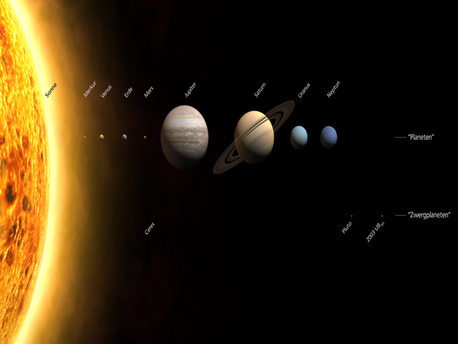Categorization of Celestial Objects
Why is Pluto no longer a planet?
 © IAU/Martin Kornmesser/DLR
|
This picture shows the eight classical planets and the three dwarf planets in the Solar System. Since the resolution at the 26th plenary meeting of the International Astronomical Union (IAU), Pluto is now 'only' a dwarf planet.
Three classes: classical planets, dwarf and planetoids
Pluto does not satisfy the third criterion - although it fulfills the first two, it was named a 'dwarf planet' together with Ceres (see also the astronomic question from week 31) and Eris (which orbits the Sun outside Neptune's orbit). The updated Solar System now has three categories of planet: the eight classical planets – Mercury to Neptune, a slowly growing number of dwarf planets and the irregularly formed planetoids or Small Solar System Bodies (SSSBs).
There are already new mnemonics for remembering the order of the eight planets (moving away from the Sun), including "My Very Elegant Mother Just Served Us Nachos" - Mercury, Venus, Earth, Mars, Jupiter, Saturn, Uranus, Neptune.
Source: German Aerospace Center
Categorization of Celestial Objects
Why is Pluto no longer a planet?
 © IAU/Martin Kornmesser/DLR
|
This picture shows the eight classical planets and the three dwarf planets in the Solar System. Since the resolution at the 26th plenary meeting of the International Astronomical Union (IAU), Pluto is now 'only' a dwarf planet.
Three classes: classical planets, dwarf and planetoids
Pluto does not satisfy the third criterion - although it fulfills the first two, it was named a 'dwarf planet' together with Ceres (see also the astronomic question from week 31) and Eris (which orbits the Sun outside Neptune's orbit). The updated Solar System now has three categories of planet: the eight classical planets – Mercury to Neptune, a slowly growing number of dwarf planets and the irregularly formed planetoids or Small Solar System Bodies (SSSBs).
There are already new mnemonics for remembering the order of the eight planets (moving away from the Sun), including "My Very Elegant Mother Just Served Us Nachos" - Mercury, Venus, Earth, Mars, Jupiter, Saturn, Uranus, Neptune.
Source: German Aerospace Center






